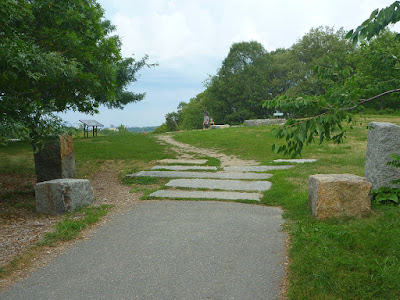 |
| Arnold Arboretum, Boston, Massachusetts |
The Harvard-managed
Arnold Arboretum is a park, forest and botanical garden all in one. This Boston landmark is large enough to get lost therein, to find a quiet place or to perform your work-out routine. Park roads, trails and narrow paths connect the points of interest, including the
Hunnewell Visitor Center, special gardens and plant selections, research areas, meadows, ponds and hills. Arboretum rules allow climbing the hills, but forbid climbing the trees. The
Arnold Arboretum map provides an overview of the arboretum landscape and its sites, which you may want to explore on your own by
self-guided tours.
 |
| Paperbark maple (Acer griseum), native to Central China | | |
|
According to the City of Boston website, today's Arboretum displays world renowned collections of
maples,
crabapples,
lilacs and
rhododendrons [1]. My TimeOut Boston Guide summarizes [2]:
The arboretum, one of the world's leading centres for plant study, was established in 1872. In a beautiful, 265-acre park setting, this living museum is administered by Harvard University. It provides the opportunity to see more than 15,000 specimens of trees and plants from around the world.
The Arnold Arboretum was the first arboretum in the United States [3,4]. It is named for
James Arnold (1781-1868), a whaling merchant of New Bedford, Massachusetts, who transferred a portion of his estate to the President and Fellows of Harvard College to establish an arboretum [4]:
Charles Sprague Sargent (1841-1927) was appointed the Arboretum's first director in 1873 and spent the following 54 years shaping the policies and programs of the Arnold Arboretum. Since its inception, it has served as a model and benchmark for similar institutions, both in North America and elsewhere.
 |
| White oak (Quercus alba), native to Eastern North America |
Getting to the Arnold Arboretum in south Boston
The Arnold Arboretum is located in the
Jamaica Plain and Roslindale sections of
Boston,
Massachusetts. A good starting point for your first exploration of the park is the
Hunnewell Building, a
National Historic Landmark that houses the Arboretum's
visitor center. Address: 125 Arborway, Boston, MA. The arboretum is open to the public every day of the year—from sunrise to sunset. There is no admission for the visitor center/museum.
If you plan to come via
commuter rail, take the
Orange Line south to its terminal
Forest Hills MBTA station. Walk to the south-west side of the station past the bus stops and find the
Washington Street Gate across Washington Street. This is the beginning of the
Blackwell Footpath. This trail traverses
Bussey Brook Meadow and ends at the
South Street Gate, a central point within the Arboretum. From there, follow northbound trails to get to the
Bradley Rosaceous Collection, the
Leventritt Shrub & Vine Garden and the visitor center at the northern tip of the park. Follow southwest-bound trails to get to
Peters Hill, a
240-feet drumlin, from where you can overlook the park and see the distant Boston's skyline.
 |
| Japanese maple (Acer palmatum) in the Larz Anderson Bonsai Collection |
References and more to explore
[1] City of Boston:
Arnold Arboretum, established in 1872 [
www.cityofboston.gov/Parks/emerald/arnold.asp].
[2]
TimeOut Boston. Time Out Guides Ltd, London, United Kingdom, 2015; page 154.
[3]
The Establishment of Arnold Arboretum [
www.nps.gov/nr/twhp/wwwlps/lessons/56arnold/56facts1.htm].
[4] The Arnold Arboretum:
Our History [
www.arboretum.harvard.edu/about/our-history].
 The Blackwell Footpath connects the South Street Gate in Boston's Arnold Arboretum with the Washington Street Gate southwest of the Forest Hills MBTA Station. Within minutes, you can be in an urban ecosystem and protected landscape, while leaving the train station. After passing the Blackwell Footpath rock, shown above, the trail descends into Bussey Brook Meadow. A Welcome panel describes the meadow path as follows:
The Blackwell Footpath connects the South Street Gate in Boston's Arnold Arboretum with the Washington Street Gate southwest of the Forest Hills MBTA Station. Within minutes, you can be in an urban ecosystem and protected landscape, while leaving the train station. After passing the Blackwell Footpath rock, shown above, the trail descends into Bussey Brook Meadow. A Welcome panel describes the meadow path as follows:























